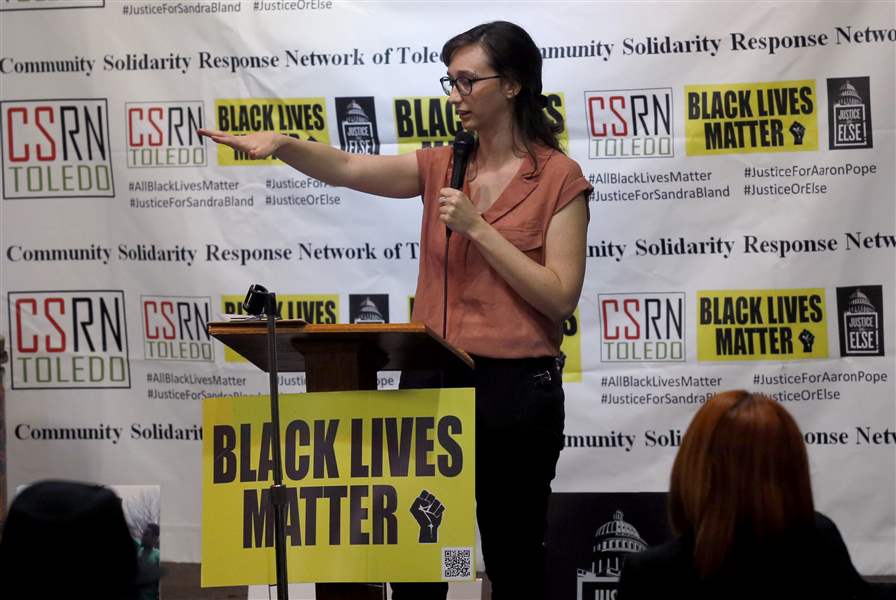
Toledoans call on city to pull out of safety partnership with Department of Justice
5/16/2018
Emma Keeshin, ACLU legal assistant, gives directions for break-out sessions during the Community Solidarity Response Network of Toledo meeting at the Frederick Douglass Community Center in Toledo.
THE BLADE/LORI KING
Buy This Image

Emma Keeshin, ACLU legal assistant, gives directions for break-out sessions during the Community Solidarity Response Network of Toledo meeting at the Frederick Douglass Community Center in Toledo.
A more diverse police force, an end to the prison-to-school pipeline, and elected officials who stand up for their constituents. Those are some key things Toledoans say they want to see in order to feel safe in their city.
About 45 community members met at the Frederick Douglass Community Center on Wednesday for a conversation about what safety means to them. The Community Solidarity Response Network and the American Civil Liberties Union of Ohio hosted the event to discuss Toledo’s involvement in the U.S. Department of Justice’s National Public Safety Partnership.
Toledo is one of 12 cities across the country the DOJ picked last year to take part in the partnership, billed as a program to assist local law enforcement and prosecutors in combating violent crime.
Toledo police officials said it’s meant to help them assess crime levels and their department’s effectiveness, but critics contend the program only focuses on the safety of certain groups at the expense of communities of color and low-income communities.
“The war on drugs turned into an opportunity to incarcerate black men and women, especially black men, at an exorbitant rate, in the ’80s,” said Ruth Leonard, who helped organize the event. “The war on violence gives me the same chills up my spine that I’m sure gave my parents in the ’80s of having an obscure title that allows interpretation across the board.”
CSRN and the ACLU have asked Toledo’s leaders to pull out of the program. If they don’t, leaders of those organizations said they at least want to make sure the community is aware of what the partnership means and can have a dialogue with local law enforcement.
Ruth Leonard, with the Community Solidarity Response Network, explains the purpose of tonight’s meeting. pic.twitter.com/nMkC422Orp
— Sarah Elms (@BySarahElms) May 16, 2018
“Safe can really mean a lot of different things to a lot of different people, and too often we’ve seen the idea of safety be used by governments to take away people’s rights. We’ve seen that time and again, too many times,” said Emma Keeshin, with ACLU of Ohio. “The National Public Safety Partnership ... we’re afraid that that’s designed to make only some people feel safe.”
Toledoan LaParis Grimes, 26, sat at a table with four other people, diverse in age, gender, race, and religion, and spoke candidly about when and where she feels safe and when and where she doesn’t. She said she made a point to attend Wednesday’s discussion because she wants to be involved in bettering her neighborhood.
“The police can only do so much. We’re responsible for taking care of each other and if we’re just spouting off about problems without ever offering real solutions, what are we really doing?” she said.
Ms. Grimes said she agreed with the group’s consensus that local law enforcement needs more training in how to handle diverse populations.
“When you’re dealing with people’s safety and when you’re dealing with people’s lives, I think it’s important that you’re not putting your expectations on them, but you’re learning about where they’re coming from and the trauma that they’ve faced and the experiences that they’re dealing with so you know how to respond to them,” she said.
Several Toledo police officers were in attendance to answer questions from the community. Deputy Chief Mike Troendle said the federal partnership will operate in three phases over three years. While they don’t receive direct funding from the program, officers are given the resources to travel and study tactics that are effective in other communities, he said.
Officials have so far conducted a violent crime assessment, are in the process of a major crimes assessment, and soon will do a technical assessment. That’s phase one, and it’s meant to drill down on where the high-crime areas are and whether current police tactics are effective.
“This is going to be a lot about community engagement and community involvement,” he said.
In the fall they’ll begin phase two, which is implementing new policing strategies they’ve learned through the program. In year three, they’ll analyze whether what they’ve implemented was effective, Deputy Chief Troendle said.
He acknowledged the concerns of CSRN and ACLU leadership, but he said police practices are based on data, not on how a person looks.
“We’re not looking at the racial breakup or the economic or social data. We’re looking at X crime occurred at X area. Now we have to figure out why,” he said. “Seeing what we can do to affect that environment to make changes in that neighborhood.”
Contact Sarah Elms at selms@theblade.com, 419-724-6103, or on Twitter @BySarahElms.